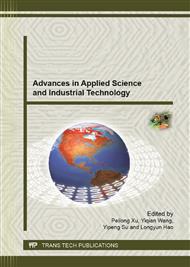[1]
Garey, M. R., Johnson, D. S., and Sethi, R. The complexity of flowshop and job shop scheduling. Mathematics of Operations Research, Vol. 1(2) (1976), pp.117-129.
DOI: 10.1287/moor.1.2.117
Google Scholar
[2]
Pezzella, F., Morganti, G., & Ciaschetti, G. A genetic algorithm for the flexible job-shop scheduling problem. Computers and Operations Research, Vol. 35 (2008), p.3202–3212.
DOI: 10.1016/j.cor.2007.02.014
Google Scholar
[3]
Liouane, N., Saad, I., Hammadi, S., & Borne, P. Ant systems & local search optimization for flexible job-shop scheduling production. International Journal of Computers, Communications & Control, Vol. 2 (2007), p.174–184.
DOI: 10.15837/ijccc.2007.2.2350
Google Scholar
[4]
Saidi-mehrabad, M., & Fattahi, P. Flexible job shop scheduling with tabu search algorithms. International Journal of Advanced Manufacturing Technology, Vol. 32 (2007), p.563–570.
DOI: 10.1007/s00170-005-0375-4
Google Scholar
[5]
Xing, L. N., Chen, Y. W., & Yang, K. W. Multi-objective flexible job shop schedule: Design and evaluation by simulation modeling. Applied Soft Computing, Vol. 9(2009), p.362–376.
DOI: 10.1016/j.asoc.2008.04.013
Google Scholar
[6]
Gao, L., Peng, C. Y., Zhou, C., Li, P. G. Solving flexible job shop scheduling problem using general particle swarm optimization. In Proceedings of the 36th CIE conference on computers & industrial engineering (2006), p.3018–3027.
Google Scholar
[7]
Paulli J. A hierarchical approach for the FMS scheduling problem. European Journal of Operational Research Vol. 86(1) (1995), P. 32–42.
DOI: 10.1016/0377-2217(95)00059-y
Google Scholar
[8]
Brandimarte P. Routing and scheduling in a flexible job shop by tabu search. Annals of Operations Research Vol. 41(1993), p.157–183.
DOI: 10.1007/bf02023073
Google Scholar
[9]
Mastrolilli M, Gambardella LM. Effective neighbourhood functions for the flexible job shop problem. Journal of Scheduling Vol. 3(1996), p.3–20.
DOI: 10.1002/(sici)1099-1425(200001/02)3:1<3::aid-jos32>3.0.co;2-y
Google Scholar
[10]
Chen H, IhlowJ, Lehmann C. Agenetic algorithm for flexible Job-shop scheduling. In: IEEE international conference on robotics and automation, Detroit; 1999. p.1120–1125.
DOI: 10.1109/robot.1999.772512
Google Scholar
[11]
Jia HZ, Nee AYC, Fuh JYH, Zhang YF. A modified genetic algorithm for distributed scheduling problems. International Journal of Intelligent Manufacturing Vol. 14(2003), p.351–362.
Google Scholar
[12]
Kacem I, Hammadi S, Borne P. Approach by localization and multiobjective evolutionary optimization for flexible job-shop scheduling problems. IEEE Transactions on Systems, Man, and Cybernetics, Part C, Vol. 32(1) (2002), P. 1–13.
DOI: 10.1109/tsmcc.2002.1009117
Google Scholar


